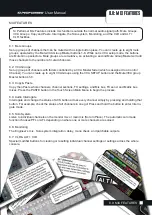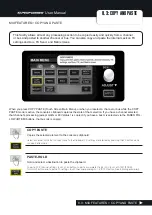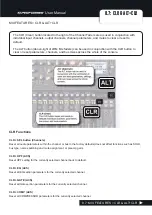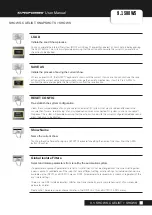
User Manual
8.5: SOLO SYSTEM
MIX FEATURES > SOLO SYSTEM
8.5: MIX FEATURES > SOLO SYSTEM
Solo provides a way of monitoring and checking individual channels and groups of channels quickly
by routing only the ‘soloed’ channels either to the monitoring system (normal operation) or to the
main mix outputs (Solo In Place - SIP).
There are two main types of SOLO: PFL (Pre Fade Listen) and AFL (After Fade Listen). The difference between the
two is the ‘tap’ where the solo source is taken from in the selected channel - pre- or post-fader.
The console has an ‘AUTO’ Input Solo mode (default) that uses intelligent automatic soloing to provide the best source
for any given task or SOLO key operation. If only a single input channel is soloed then PFL routing will be used. If two
or more input channels or any output channel are soloed then AFL routing will be used. You can also set the Input
Solo Mode as PFL only, or AFL only.
Highlight and Blend settings in the Solo Settings menu allow control ‘background’ levels. ‘Highlight’ allows a soloed
channel to stand out by attenuating other soloed channels by the required amount. It is activated by pressing and
holding a Solo button. ‘Blend’ sets an attenuation level for the whole monitor source so you can dial in a certain
amount of background with any soloed channels.
Solo In Place (SIP) is a Solo mode that routes the soloed signal to the main mix outputs. This can be useful, for
example, during sound check where you want to quickly select specific sources for checking. The Solo In Place mode
is activated via the Solo Settings Menu (Touch Screen) to prevent accidental activation during performance.
WARNING: Solo In Place Mode will interrupt the Main Mix outputs. Do not activate during performance.
















































